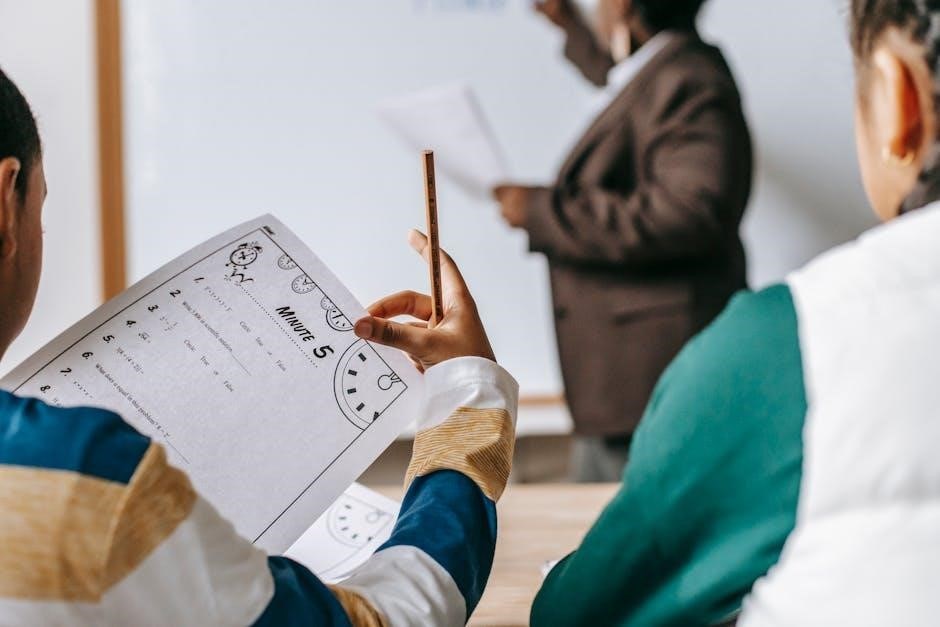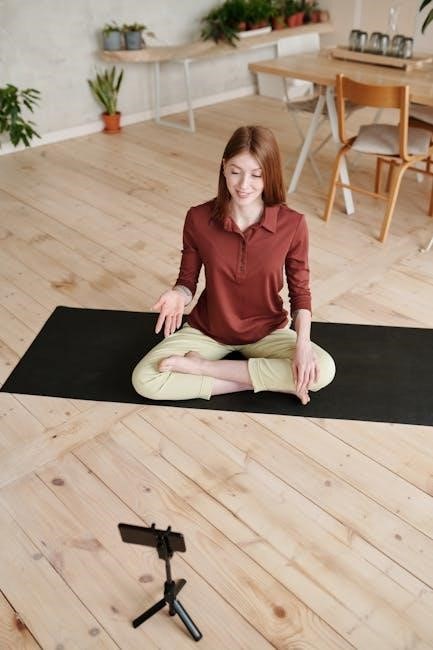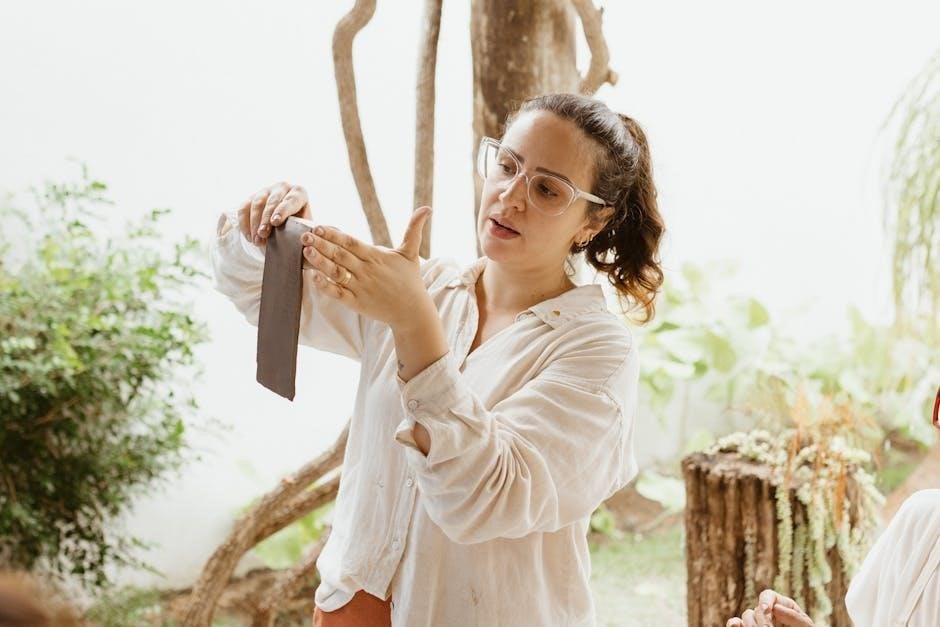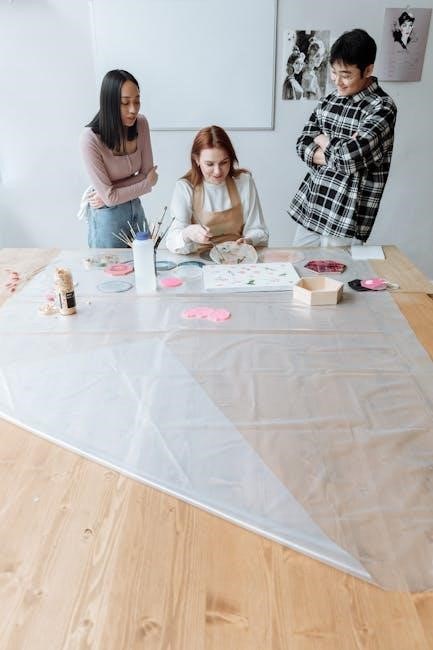Before the Tutorial
Before the tutorial, preparation is key to ensuring a productive and structured session. This phase sets the foundation for the entire process, guiding students through the 10 steps of the AVID tutorial process. First, pre-tutorial preparation involves identifying the topic or issue to be addressed, ensuring clarity and focus. This step helps students and tutors understand the objective, making the session more effective.
Next, setting the agenda is crucial. It outlines the goals and activities for the tutorial, keeping everyone on track. This step ensures that time is used efficiently and that all key points are covered. Additionally, gathering materials is essential. Students should collect relevant resources, such as textbooks, notes, or online references, to support their learning during the session.
Finally, establishing a positive environment fosters collaboration and confidence. Tutors encourage open communication, creating a safe space for students to ask questions and share ideas. These steps collectively prepare students to engage actively in the tutorial process, laying the groundwork for successful outcomes. By focusing on these pre-tutorial elements, students can maximize their learning experience.
1.1. Pre-Tutorial Preparation
Pre-tutorial preparation is a critical step in the AVID 10-step tutorial process, as it lays the groundwork for a productive and focused session. This phase ensures that both tutors and students are well-prepared to address the topic or issue at hand. Effective preparation not only saves time but also enhances the quality of the tutorial, making it more engaging and beneficial for everyone involved.
Identifying the Topic or Issue
The first step in pre-tutorial preparation is to clearly identify the topic or issue that will be addressed during the session. This involves understanding the specific challenge or question that the student wants to explore. Whether it’s a math problem, a writing assignment, or a concept from a science class, having a well-defined focus ensures that the tutorial remains targeted and relevant. Tutors should work with students to narrow down the topic to a manageable scope, avoiding broad or vague areas that might lead to confusion.
Researching and Organizing Information
Once the topic is identified, the next step is to gather and organize relevant information. Students should review their class notes, textbooks, and any other resources that might be useful for the tutorial. Tutors can also contribute by bringing additional materials or providing context that might help clarify the topic. Organizing the information into a logical structure, such as an outline or a list of key points, helps to streamline the discussion and ensure that all important aspects are covered.
Planning the Discussion
Pre-tutorial preparation also involves planning how the discussion will unfold. Tutors and students should agree on the format of the session, whether it will be a group discussion, a one-on-one meeting, or a combination of both. They should also establish a timeline for covering the material, allocating specific amounts of time to each section or question. This planning helps to keep the tutorial on track and ensures that all participants are aligned in their goals.
Setting Clear Objectives
Another important aspect of pre-tutorial preparation is setting clear objectives for the session. These objectives should be specific, measurable, and achievable, providing a roadmap for what the student hopes to accomplish by the end of the tutorial. For example, the objective might be to understand a particular concept, solve a specific type of problem, or improve a certain skill. Having well-defined objectives helps to maintain focus and ensures that the tutorial is productive.
Additional Preparation Tasks
Depending on the topic or the needs of the student, there may be additional tasks that need to be completed before the tutorial. For example, the student might need to complete some background reading, watch a video, or practice a specific skill. Tutors might also need to prepare examples, exercises, or other resources to support the student’s learning. These tasks should be identified and assigned during the pre-tutorial phase to ensure that everyone is ready for the session.
Creating a Positive and Collaborative Environment
Finally, pre-tutorial preparation involves creating a positive and collaborative environment for the session. This includes ensuring that the physical space is comfortable and free from distractions, as well as establishing a supportive and respectful atmosphere. Tutors should encourage open communication and active participation, making students feel comfortable asking questions and sharing their thoughts. A positive environment not only enhances the learning experience but also fosters a sense of community and cooperation.
1.2. Setting the Agenda
Setting the agenda is a vital step in the AVID 10-step tutorial process, as it provides a clear roadmap for the session and ensures that all participants are aligned in their goals and expectations. An effective agenda not only helps to organize the discussion but also maximizes the use of time, making the tutorial more productive and focused. Whether the session is conducted in a group or one-on-one setting, having a well-structured agenda is essential for achieving the desired outcomes.

Importance of an Agenda

The agenda serves as a guide for the tutorial, outlining the specific topics or issues that will be addressed, the order in which they will be discussed, and the time allocated to each. This helps to prevent the session from becoming disorganized or sidetracked, ensuring that all key points are covered. Additionally, an agenda provides students with a sense of direction, allowing them to prepare mentally for the topics that will be explored. It also helps tutors to stay focused and ensure that the session progresses smoothly.
Creating the Agenda

Creating an effective agenda begins with identifying the main objectives of the tutorial. These objectives should be specific, measurable, and achievable, providing a clear framework for the session. For example, if the tutorial is focused on improving writing skills, the objectives might include understanding the structure of an essay, practicing paragraph development, or enhancing grammar and punctuation. Once the objectives are established, the agenda can be structured to address each one in a logical sequence.

Key Components of an Agenda
A well-structured agenda typically includes several key components. First, it should outline the topic or issue that will be addressed, providing a clear focus for the session. Second, it should list the specific objectives or goals that the student hopes to achieve by the end of the tutorial. Third, it should detail the activities or exercises that will be used to address the topic, such as group discussions, problem-solving exercises, or hands-on practice. Finally, it should include a timeline, specifying how much time will be allocated to each activity or topic.
Involving Students in Agenda Setting
Involving students in the process of setting the agenda can enhance their engagement and motivation. By allowing students to contribute to the agenda, tutors can ensure that the session addresses their specific needs and concerns. For example, if a student is struggling with a particular concept or skill, they can request that it be included in the agenda. This not only makes the tutorial more relevant to the student’s needs but also encourages them to take an active role in their learning process.
Flexibility in the Agenda
While an agenda provides a structured framework for the tutorial, it is important to remain flexible. Sometimes, the discussion may take an unexpected turn, or a student may need more time to understand a particular concept. In such cases, the agenda should be adjusted to accommodate these needs, ensuring that the session remains effective and responsive to the student’s learning requirements. Flexibility also allows for the incorporation of new ideas or insights that may arise during the discussion, enriching the learning experience.
Using Tools to Support Agenda Setting

There are several tools and resources that can support the process of setting the agenda. For example, tutors can use a template or checklist to ensure that all key components are included. They can also use digital tools, such as shared documents or project management software, to collaborate with students in creating and modifying the agenda. Additionally, visual aids like mind maps or flowcharts can help to organize the topics and activities in a way that is easy to understand and follow.
Impact of a Well-Structured Agenda
A well-structured agenda has a positive impact on the overall tutorial process. It helps to create a sense of clarity and purpose, ensuring that the session is focused and productive. By outlining the topics and activities in advance, the agenda reduces confusion and ensures that all participants are on the same page. It also helps to build confidence and motivation in students, as they can see the progress being made toward their learning goals. Furthermore, a clear agenda allows tutors to assess the effectiveness of the session and make adjustments as needed, ensuring that the tutorial process continues to meet the student’s needs.
1.3. Gathering Materials
Gathering materials is a critical step in the AVID 10-step tutorial process, as it ensures that both tutors and students have the necessary resources to engage effectively in the session. This step is essential for creating a productive and focused learning environment. The materials gathered will serve as the foundation for the discussion, activities, and problem-solving exercises that take place during the tutorial. By having all the required resources readily available, students and tutors can minimize distractions and maximize the time spent on achieving the session’s objectives.

Why Gathering Materials is Important
Gathering materials is not just about collecting random resources; it is about selecting the most relevant and useful ones that align with the tutorial’s goals. The right materials can enhance understanding, provide clarity, and support the learning process. For example, if the tutorial focuses on improving writing skills, having access to grammar guides, essay examples, and writing exercises can be invaluable; Similarly, for math or science tutorials, having textbooks, worksheets, or online resources can provide the necessary support for problem-solving.
Types of Materials to Gather
The specific materials needed will vary depending on the topic or subject of the tutorial. However, there are some common types of materials that are generally useful. These include:
- Textbooks and Workbooks: These are essential for providing foundational knowledge and structured exercises. Students should ensure they have the correct editions and relevant chapters marked or highlighted.
- Notes and Handouts: Class notes, study guides, and handouts from teachers can provide additional insights and examples. Organizing these materials in a binder or digital folder can make them easier to access during the tutorial.
- Online Resources: Websites, educational apps, and online tutorials can supplement traditional materials. Students should bookmark or save links to relevant resources beforehand to avoid wasting time searching during the session.
- Writing Utensils and Paper: While many tutorials may be digital, having a notebook and pen can be useful for jotting down key points, brainstorming ideas, or completing practice exercises.
- Technology: Laptops, tablets, or smartphones can be used to access digital materials, collaborate on documents, or participate in online activities. Ensuring that devices are fully charged and connected to the internet is crucial.
- Specific Assignments or Projects: If the tutorial is focused on a particular assignment or project, students should bring all relevant materials, such as drafts, research, or outlines.
How to Gather Materials Effectively
Gathering materials effectively requires organization and planning. Students should start by identifying the specific needs of the tutorial and making a list of the materials they require. This list can be created in collaboration with the tutor or based on the agenda set during the previous step. Once the list is made, students should systematically gather each item, ensuring that they are complete and in good condition.
Creating a Checklist
To ensure that no essential materials are forgotten, students can create a checklist. This checklist should include all the items they need to bring to the tutorial, as well as any specific tasks they need to complete beforehand, such as reading a chapter or completing a practice exercise. By going through the checklist, students can verify that they have everything they need before the session begins.

Organizing Materials
Once the materials are gathered, they should be organized in a way that makes them easy to access during the tutorial. This can be done by categorizing materials into folders or sections, such as notes, handouts, and practice exercises. For digital materials, students can use cloud storage services like Google Drive or Dropbox to ensure that they can access their files from any device. Organizing materials not only saves time but also helps to create a more efficient and productive learning environment.
The Role of the Tutor in Gathering Materials
While the primary responsibility for gathering materials lies with the student, tutors can also play a supportive role. Tutors can provide guidance on which materials are most relevant, suggest additional resources, and help students organize their materials effectively. By working together, students and tutors can ensure that they have everything they need to make the tutorial a success.
Benefits of Gathering Materials
Gathering materials offers several benefits that can enhance the tutorial experience. First, it ensures that students are prepared and can engage fully in the session without distractions. Second, it allows tutors to focus on teaching and guiding, rather than spending time searching for materials. Finally, it creates a sense of accountability and responsibility, as students take an active role in their learning process.
Challenges and Solutions

Despite its importance, gathering materials can sometimes present challenges. One common issue is forgetting to bring essential items, which can disrupt the flow of the session. To overcome this, students can create a routine of checking their materials before each tutorial. Another challenge is managing digital materials, which can sometimes be difficult to access or organize. Using cloud storage and bookmarking tools can help to mitigate this issue. By anticipating potential challenges and developing strategies to address them, students can ensure that they are well-prepared for their tutorials.
Gathering materials is a fundamental step in the AVID 10-step tutorial process, as it lays the groundwork for a successful and productive session. By identifying the necessary resources, creating a checklist, organizing materials, and overcoming potential challenges, students can take control of their learning experience. With the right materials in hand, students and tutors can focus on achieving the tutorial’s objectives, leading to greater understanding, improved skills, and increased confidence. This step not only enhances the quality of the tutorial but also reinforces the importance of preparation and organization in the learning process.

1.4. Establishing a Positive Environment
Establishing a positive environment is a cornerstone of the AVID 10-step tutorial process. This step ensures that the tutorial space is conducive to learning, collaboration, and growth. A positive environment not only enhances the effectiveness of the session but also fosters a sense of community and mutual respect among participants. By creating a welcoming and inclusive atmosphere, tutors and students can work together more effectively, leading to better outcomes and a more enjoyable experience.
Why a Positive Environment Matters
The environment in which a tutorial takes place plays a significant role in determining its success. A positive environment encourages active participation, creativity, and open communication. It helps students feel comfortable asking questions, sharing ideas, and taking risks, all of which are essential for learning. A positive environment also reduces anxiety and stress, allowing students to focus on the task at hand. For tutors, a positive environment makes it easier to guide and support students effectively, creating a more dynamic and engaging experience for everyone involved.
Key Elements of a Positive Environment
Creating a positive environment involves several key elements that work together to foster a productive and supportive atmosphere. These include:
- Respect and Inclusivity: Ensuring that all participants feel valued and respected is fundamental. Tutors should encourage diversity of thought and ensure that every student’s voice is heard.
- Open Communication: Encouraging open and honest communication helps build trust and fosters collaboration. Students should feel comfortable expressing their thoughts and ideas without fear of judgment.
- Positive Attitude: A positive attitude from both tutors and students can significantly impact the environment. Encouraging a growth mindset and focusing on solutions rather than problems can create a more optimistic and productive atmosphere.
- Physical Space: The physical layout of the tutorial space can also influence the environment. Ensuring that the space is comfortable, well-lit, and free from distractions can help create a more focused and positive setting.
Strategies for Creating a Positive Environment
Creating a positive environment requires intentional effort and strategies. Tutors and students can work together to establish a supportive and inclusive atmosphere. Some effective strategies include:
- Icebreakers and Team-Building Activities: Starting the tutorial with a brief icebreaker or team-building activity can help establish rapport and create a sense of camaraderie among participants. This can be especially helpful in group tutorials where students may not know each other well.
- Active Listening: Encouraging active listening can foster a sense of respect and understanding. Tutors and students should make an effort to truly hear and consider each other’s perspectives, rather than simply waiting for their turn to speak.
- Positive Reinforcement: Offering positive reinforcement, such as praise or constructive feedback, can boost confidence and motivation. Tutors should acknowledge students’ efforts and progress, no matter how small.
- Encouraging Participation: Tutors should strive to create an environment where all students feel encouraged to participate. This can be achieved by asking open-ended questions, providing opportunities for reflection, and ensuring that no single student dominates the conversation.
- Addressing Challenges with Empathy: When challenges or conflicts arise, they should be addressed with empathy and understanding. Tutors can model problem-solving skills and help students navigate difficult situations in a constructive manner.
The Role of the Tutor in Establishing a Positive Environment
Tutors play a crucial role in establishing and maintaining a positive environment. Their attitude, behavior, and approach set the tone for the session. Tutors should strive to create a balance between structure and flexibility, ensuring that the tutorial is both productive and enjoyable. By being approachable, empathetic, and supportive, tutors can help students feel more at ease and engaged.
The Role of Students in Establishing a Positive Environment
Students also have a responsibility to contribute to a positive environment. By being respectful, open-minded, and actively engaged, students can help create a supportive and inclusive atmosphere. Taking initiative, asking questions, and sharing ideas can enhance the learning experience for everyone involved. Students should also be mindful of their body language and tone, ensuring that they convey positivity and enthusiasm.
Benefits of a Positive Environment
A positive environment offers numerous benefits that extend beyond the tutorial session itself. It can lead to increased student engagement, improved learning outcomes, and stronger relationships between tutors and students. A positive environment also fosters resilience and perseverance, helping students to stay motivated even when faced with challenges. By creating a supportive and inclusive atmosphere, tutors and students can work together to achieve their goals and make the most of the tutorial experience.
Challenges and Solutions
While establishing a positive environment is crucial, it can also present challenges. One common challenge is managing differing personalities or conflicting opinions within a group. To address this, tutors can establish clear expectations for behavior and communication at the outset. Another challenge is maintaining engagement and focus, especially during longer sessions. Incorporating breaks, movement, or interactive activities can help keep students engaged and maintain a positive atmosphere. By being proactive and flexible, tutors and students can overcome these challenges and create a productive and enjoyable environment.
Establishing a positive environment is an essential step in the AVID 10-step tutorial process. By fostering respect, open communication, and a positive attitude, tutors and students can create a supportive and inclusive atmosphere that enhances learning and collaboration; While challenges may arise, they can be addressed through intentional strategies and a commitment to maintaining a positive environment. The benefits of a well-established positive environment are numerous, leading to increased engagement, improved outcomes, and stronger relationships. By prioritizing this step, tutors and students can set the stage for a successful and meaningful tutorial experience.


Leave a Reply
You must be logged in to post a comment.